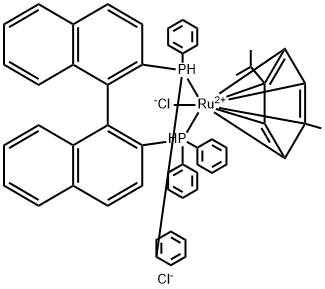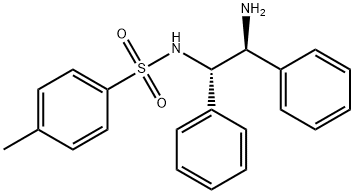(S,S)-N-(p-Toluenesulfonyl)-1,2-diphenylethanediamine(chloro)(p-cymene)ruthenium(II)
Synonym(s):
- CAS NO.:192139-90-5
- Empirical Formula: C31H30ClN2O2RuS
- Molecular Weight: 631.17
- MDL number: MFCD09953484
- SAFETY DATA SHEET (SDS)
- Update Date: 2024-03-18 16:05:02

What is (S,S)-N-(p-Toluenesulfonyl)-1,2-diphenylethanediamine(chloro)(p-cymene)ruthenium(II)?
Chemical properties
Solid
The Uses of (S,S)-N-(p-Toluenesulfonyl)-1,2-diphenylethanediamine(chloro)(p-cymene)ruthenium(II)
Catalyst involved in: ? Asymmetric transfer hydrogenation of imines and ketones ? Intramolecular asymmetric reductive amination ? Tandem hydroformylation / hydrogenation of terminal olefins Reactant involved in studies of thermal decomposition of arenerut
The Uses of (S,S)-N-(p-Toluenesulfonyl)-1,2-diphenylethanediamine(chloro)(p-cymene)ruthenium(II)
Catalyst involved in:
- Asymmetric transfer hydrogenation of imines and ketones
- Intramolecular asymmetric reductive amination
- Tandem hydroformylation / hydrogenation of terminal olefins
Reactant involved in studies of thermal decomposition of areneruthenium chiral amido-amine alkyl complexes
General Description
RuCl(p-cymene)[(S,S)-Ts-DPEN] is a chiral diamine ligand complexed with ruthenium, which can be used for the asymmetric transfer hydrogenation of a variety of imines.
Properties of (S,S)-N-(p-Toluenesulfonyl)-1,2-diphenylethanediamine(chloro)(p-cymene)ruthenium(II)
| Melting point: | >175 °C |
| alpha | 178o (C=0.5 IN CHLOROFORM) |
| storage temp. | 2-8°C |
| solubility | soluble in Chloroform, DCM, Ethyl Acetate |
| form | solid |
| color | yellow to dark brown |
| optical activity | [α]20/D +178°, c = 0.5 in chloroform |
| Sensitive | air sensitive |
Safety information for (S,S)-N-(p-Toluenesulfonyl)-1,2-diphenylethanediamine(chloro)(p-cymene)ruthenium(II)
| Signal word | Warning |
| Pictogram(s) |
 Exclamation Mark Irritant GHS07 |
| GHS Hazard Statements |
H315:Skin corrosion/irritation H319:Serious eye damage/eye irritation H335:Specific target organ toxicity, single exposure;Respiratory tract irritation |
| Precautionary Statement Codes |
P261:Avoid breathing dust/fume/gas/mist/vapours/spray. P305+P351+P338:IF IN EYES: Rinse cautiously with water for several minutes. Remove contact lenses, if present and easy to do. Continuerinsing. |
Computed Descriptors for (S,S)-N-(p-Toluenesulfonyl)-1,2-diphenylethanediamine(chloro)(p-cymene)ruthenium(II)
| InChIKey | DCJKLKCGNMDXFR-MNPNNRAMNA-M |
| SMILES | [Cl-][Ru+2]123456(N[C@@H](C7C=CC=CC=7)[C@H](C7C=CC=CC=7)[N-]1S(C1C=CC(C)=CC=1)(=O)=O)C1(C)C2=C3C4(C(C)C)=C5C6=1 |&1:3,10,r| |
(S,S)-N-(p-Toluenesulfonyl)-1,2-diphenylethanediamine(chloro)(p-cymene)ruthenium(II) manufacturer
Johnson Matthey Chemicals India Pvt Ltd
1Y
Phone:+91-9711869003
Whatsapp: +91-9711869003
product: RuCl(p-cymene)[(S,S)-Ts-DPEN] 192139-90-5 98%
New Products
(S)-3-Aminobutanenitrile hydrochloride 4-Methylphenylacetic acid N-Boc-D-alaninol N-BOC-D/L-ALANINOL Tert-butyl bis(2-chloroethyl)carbamate 3-Morpholino-1-(4-nitrophenyl)-5,6-dihydropyridin- 2(1H)-one Furan-2,5-Dicarboxylic Acid Tropic acid 1-Bromo-3,5-Di-Tert-Butylbenzene S-2-CHLORO PROPIONIC ACID ETHYL ISOCYANOACETATE 2-Bromo-1,3-Bis(Dimethylamino)Trimethinium Hexafluorophosphate 4-IODO BENZOIC ACID 3-NITRO-2-METHYL ANILINE 1-(2,4-DICHLOROPHENYL) ETHANAMINE (2-Hydroxyphenyl)acetonitrile 4-Bromopyrazole 2-(Cyanocyclohexyl)acetic acid 4-methoxy-3,5-dinitropyridine 1-(4-(aminomethyl)benzyl)urea hydrochloride 2-aminopropyl benzoate hydrochloride diethyl 2-(2-((tertbutoxycarbonyl)amino) ethyl)malonate tert-butyl 4- (ureidomethyl)benzylcarbamate Ethyl-2-chloro((4-methoxyphenyl)hydrazono)acetateRelated products of tetrahydrofuran
![((R,R)-2-AMINO-1,2-DIPHENYLETHYL)[(4-TOLYL)SULFONYL]AMIDO](P-CYMENE)RUTHENIUM(II)CHLORIDE](https://img.chemicalbook.in/CAS/GIF/192139-92-7.gif)



![CHLORO[(1S,2S)-N-(P-TOLUENESULFONYL)-1,2-DIPHENYL-1,2-ETHANEDIAMINE] (P-CYMENE)RUTHENIUM(II)](https://img.chemicalbook.in/StructureFile/ChemBookStructure6/GIF/CB9181942.gif)



You may like
-
![192139-90-5 RuCl(p-cymene)[(S,S)-Ts-DPEN] 98%](https://img.chemicalbook.in//ProductImageIndia/2024-03/Raw/2e1c2046-e6bd-4a2b-995b-7f5cce4a5750.png) 192139-90-5 RuCl(p-cymene)[(S,S)-Ts-DPEN] 98%View Details
192139-90-5 RuCl(p-cymene)[(S,S)-Ts-DPEN] 98%View Details
192139-90-5 -
 192139-90-5 99%View Details
192139-90-5 99%View Details
192139-90-5 -
![RuCl(p-cymene)[(S,S)-Ts-DPEN] 192139-90-5 98%](https://img.chemicalbook.in//ProductImageIndia/2024-03/Raw/a24ce171-40a9-4c1a-a795-75624722b3e3.png) RuCl(p-cymene)[(S,S)-Ts-DPEN] 192139-90-5 98%View Details
RuCl(p-cymene)[(S,S)-Ts-DPEN] 192139-90-5 98%View Details
192139-90-5 -
 (S,S)-N-(p-Toluenesulfonyl)-1,2-diphenylethanediamine(chloro)(p-cymene)ruthenium(II), 97% CAS 192139-90-5View Details
(S,S)-N-(p-Toluenesulfonyl)-1,2-diphenylethanediamine(chloro)(p-cymene)ruthenium(II), 97% CAS 192139-90-5View Details
192139-90-5 -
 CAS 192139-90-5](https://img.chemicalbook.in//Content/image/CP5.jpg) RuCl[(S,S)-Tsdpen](p-cymene) CAS 192139-90-5View Details
RuCl[(S,S)-Tsdpen](p-cymene) CAS 192139-90-5View Details
192139-90-5 -
![RuCl(p-cymene)[(S,S)-Ts-DPEN] 95.00% CAS 192139-90-5](https://img.chemicalbook.in//Content/image/CP5.jpg) RuCl(p-cymene)[(S,S)-Ts-DPEN] 95.00% CAS 192139-90-5View Details
RuCl(p-cymene)[(S,S)-Ts-DPEN] 95.00% CAS 192139-90-5View Details
192139-90-5 -
![RuCl(p-cymene)[(S,S)-Ts-DPEN] CAS 192139-90-5](https://img.chemicalbook.in//Content/image/CP5.jpg) RuCl(p-cymene)[(S,S)-Ts-DPEN] CAS 192139-90-5View Details
RuCl(p-cymene)[(S,S)-Ts-DPEN] CAS 192139-90-5View Details
192139-90-5 -
 118753-70-1 98+View Details
118753-70-1 98+View Details
118753-70-1
Statement: All products displayed on this website are only used for non medical purposes such as industrial applications or scientific research, and cannot be used for clinical diagnosis or treatment of humans or animals. They are not medicinal or edible.